JS-Function_Object
引言
这篇文章深入探究下 Function.__proto__ === Function.prototype 引起的鸡生蛋蛋生鸡问题,并在这个过程中深入了解 Object.prototype. Function.prototype. function Object . function Function 之间的关系。
Object.prototype
Object.prototype 表示 Object 的原型对象,其 [[Prototype]] 属性是 null,访问器属性 __proto__ 暴露了一个对象的内部 [[Prototype]] 。 Object.prototype 并不是通过 Object 函数创建的,为什么呢?看如下代码
function Foo() {
this.value = "foo";
}
let f = new Foo();
f.__proto__ === Foo.prototype;
// true
实例对象的 __proto__指向构造函数的 prototype,即 f.__proto__ 指向 Foo.prototype,但是 Object.prototype.__proto__ 是 null,所以 Object.prototype 并不是通过 Object 函数创建的,那它如何生成的?其实 Object.prototype 是浏览器底层根据 ECMAScript 规范创造的一个对象。
Object.prototype 就是原型链的顶端(不考虑 null 的情况下),所有对象继承了它的 toString 等方法和属性。
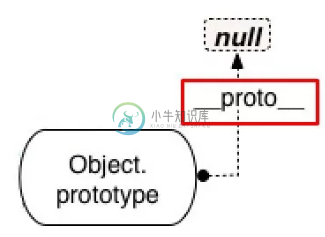
Function.prototype
Function.prototype 对象是一个函数(对象),其 [[Prototype]] 内部属性值指向内建对象 Object.prototype。Function.prototype 对象自身没有 valueOf 属性,其从 Object.prototype 对象继承了valueOf 属性。
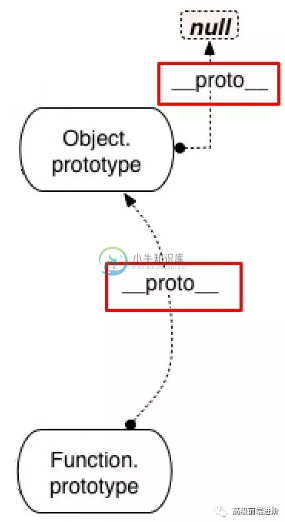
Function.prototype 的 [[Class]] 属性是 Function,所以这是一个函数,但又不大一样。为什么这么说呢?因为我们知道只有函数才有 prototype 属性,但并不是所有函数都有这个属性,因为 Function.prototype 这个函数就没有。
Function.prototype;
// ƒ () { [native code] }
Function.prototype.prototype;
// undefined
当然你会发现下面这个函数也没有 prototype 属性。
let fun = Function.prototype.bind();
// ƒ () { [native code] }
fun.prototype;
// undefined
为什么没有呢,我的理解是 Function.prototype 是引擎创建出来的函数,引擎认为不需要给这个函数对象添加 prototype 属性,不然 Function.prototype.prototype… 将无休无止并且没有存在的意义。
function Object
Object 作为构造函数时,其 [[Prototype]] 内部属性值指向 Function.prototype,即
Object.__proto__ === Function.prototype;
// true
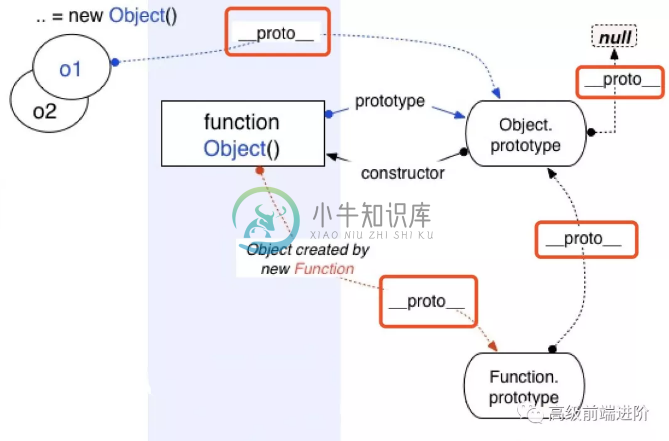
使用new Object() 创建新对象时,这个新对象的 [[Prototype]] 内部属性指向构造函数的 prototype 属性,对应上图就是 Object.prototype。
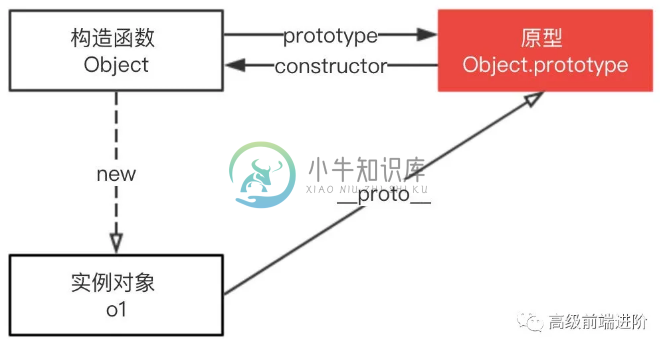
当然也可以通过对象字面量等方式创建对象。
使用对象字面量创建的对象,其
[[Prototype]]值是Object.prototype。使用数组字面量创建的对象,其
[[Prototype]]值是Array.prototype。使用
function f(){}函数创建的对象,其[[Prototype]]值是Function.prototype。使用
new fun()创建的对象,其中 fun 是由 JavaScript 提供的内建构造器函数之一(Object, Function, Array, Boolean, Date, Number, String 等等),其[[Prototype]]值是fun.prototype。使用其他 JavaScript 构造器函数创建的对象,其
[[Prototype]]值就是该构造器函数的prototype属性。
let o = { a: 1 };
// 原型链: o ---> Object.prototype ---> null
let a = ["yo", "whadup", "?"];
// 原型链: a ---> Array.prototype ---> Object.prototype ---> null
function f() {
return 2;
}
// 原型链: f ---> Function.prototype ---> Object.prototype ---> null
var fun = new Function();
// 原型链: fun ---> Function.prototype ---> Object.prototype ---> null
function Foo() {
return {};
}
let foo = new Foo();
// 原型链: foo ---> Foo.prototype ---> Object.prototype ---> null
function Function
Function 构造函数是一个函数对象,其 [[Class]] 属性是 Function。Function 的 [[Prototype]] 属性指向了 Function.prototype,即
Function.__proto__ === Function.prototype;
// true
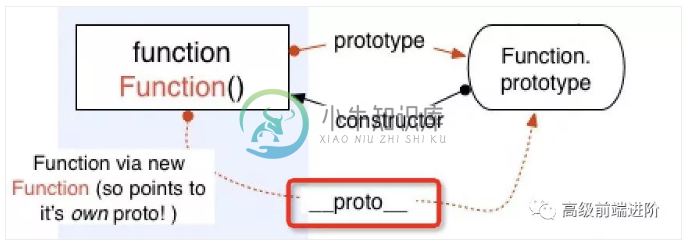
Function & Object 鸡蛋问题
我们看下面这段代码
Object instanceof Function; // true
Function instanceof Object; // true
Object instanceof Object; // true
Function instanceof Function; // true
Object 构造函数继承了 Function.prototype,同时 Function 构造函数继承了 Object.prototype。这里就产生了 鸡和蛋 的问题。为什么会出现这种问题,因为 Function.prototype 和 Function.__proto__ 都指向 Function.prototype。
// Object instanceof Function 即
Object.__proto__ === Function.prototype; // true
// Function instanceof Object 即
Function.__proto__.__proto__ === Object.prototype; // true
// Object instanceof Object 即
Object.__proto__.__proto__ === Object.prototype; // true
// Function instanceof Function 即
Function.__proto__ === Function.prototype; // true
对于 Function.__proto__ === Function.prototype 这一现象有 2 种解释,争论点在于 Function 对象是不是由 Function 构造函数创建的一个实例?
解释 1. YES:按照 JavaScript 中“实例”的定义,a 是 b 的实例即 a instanceof b 为 true,默认判断条件就是 b.prototype 在 a 的原型链上。而 Function instanceof Function 为 true,本质上即 Object.getPrototypeOf(Function) === Function.prototype,正符合此定义。
解释 2. NO:Function 是 built-in 的对象,也就是并不存在“Function对象由Function构造函数创建”这样显然会造成鸡生蛋蛋生鸡的问题。实际上,当你直接写一个函数时(如 function f() {} 或x => x),也不存在调用 Function构造器,只有在显式调用 Function 构造器时(如 new Function('x', 'return x') )才有。
这里偏向于第二种解释,即先有 Function.prototype 然后有的 function Function() ,所以就不存在鸡生蛋蛋生鸡问题了,把 Function.__proto__ 指向 Function.prototype 是为了保证原型链的完整,让 Function 可以获取定义在 Object.prototype 上的方法。
最后给一个完整的图,看懂这张图原型就没问题了。
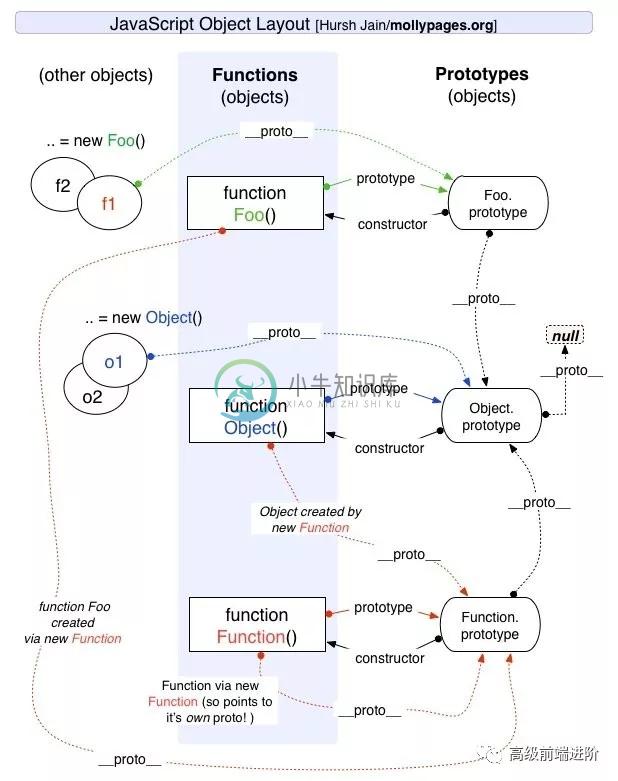
内置类型构建过程
JavaScript 内置类型是浏览器内核自带的,浏览器底层对 JavaScript 的实现基于 C/C++,那么浏览器在初始化 JavaScript 环境时都发生了什么?
用 C/C++ 构造内部数据结构创建一个 OP 即 (Object.prototype) 以及初始化其内部属性但不包括行为。
用 C/C++ 构造内部数据结构创建一个 FP 即 (Function.prototype) 以及初始化其内部属性但不包括行为。
将 FP 的 [[Prototype]] 指向 OP。
用 C/C++ 构造内部数据结构创建各种内置引用类型。
将各内置引用类型的[[Prototype]]指向 FP。
将 Function 的 prototype 指向 FP。
将 Object 的 prototype 指向 OP。
用 Function 实例化出 OP,FP,以及 Object 的行为并挂载。
用 Object 实例化出除 Object 以及 Function 的其他内置引用类型的 prototype 属性对象。
用 Function 实例化出除Object 以及 Function 的其他内置引用类型的 prototype 属性对象的行为并挂载。
实例化内置对象 Math 以及 Grobal
至此,所有内置类型构建完成。

